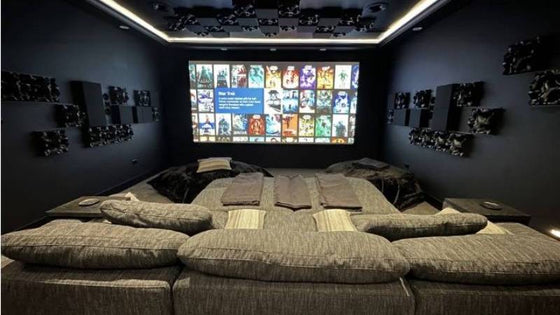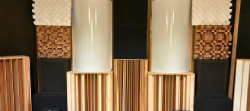Creating a system you love shouldn't be difficult. The Acoustic Frontiers blog is here to help.
Introduction
It has been known for many years that the room we listen to music in is a significant arbiter of the sound quality we enjoy. A number of different approaches have been tried over the last 40 years to remove the negative influence of the room on the quality of sound reproduction achieved from a given set of electronics. In the early days crude frequency response equalization was performed through application of analog parametric equalizers or graphic equalizers. These devices were typically not designed for high quality home audio reproduction and so gained a negative reputation amongst discerning audiophiles (whether stereo or multichannel) and home theater enthusiasts. Over the last 20 years the increasing availability of cheap and powerful digital signal processing (DSP) hardware has led audio companies to attempt to design and implement ‘digital room correction’ (sometimes abbreviated to DRC and also known as room equalization / EQ) devices.
The first company to release a product in this field was SigTech, who were followed by a number of other companies, most notably TacT, who can probably be credited with introducing room correction to the two channel audiophile market. Audyssey, a company that primarily licenses their DSP code to other manufacturers such as Denon, have been responsible for the rapid penetration of room correction into the home theater market. It is probably fair to say that digital room correction is now more embedded in the home theater than it is in audiophile systems, a likely consequence of manufacturers trying to ‘out feature’ each other in the surround sound processor market.
Despite these trends, much confusion still exists about what a room correction product does, what problems it can (and cannot) solve and therefore its ‘place’ in a modern high quality sound reproduction system. Part of the challenge of understanding room correction is that it requires a reasonable level of understanding of sound quality, acoustic science, acoustic measurement and psychoacoustics (how humans perceive sound). The majority of the articles I have read online or in print magazines do not cover the fundamentals in enough depth to allow the curious and committed reader a chance to understand room correction on anything more than a cursory level. By the end of this article I hope that you will have learnt enough to judge for yourself what room correction can and cannot do and how best to apply it in the context of a world class music or home theater system.
The conclusion I have reached from my study and from its application in my client’s systems is that room correction can be a valuable tool to address certain acoustical problems, particularly those related to room mode resonances. There are many things that room correction cannot, for want of a better word, correct. These acoustical issues can only be addressed through good design, appropriate use of acoustic treatment and calibration (e.g. speaker/listener positioning) techniques.
The first task for you on this journey is to:
It is important to take the time to study these topics, since the remainder of the discussion on room correction assumes familiarity with the terminology and language used.
How a room correction product works
The process used is, at a high level, the same for nearly all types of room correction products:
An example will help to illustrate this. At 60Hz the measured response of a nominal system is 78dB. A target has been set of 75dB. The measured response is therefore +3dB louder than target, and a correction filter of -3dB is needed. An additional example is shown in the table below; all figures are in dB:
|
Frequency
|
Measured Response
|
Target Response
|
Difference
|
Correction Filter
|
|
60
|
78
|
75
|
+3
|
-3
|
|
1000
|
73
|
75
|
-2
|
+2
|
An illustration of what occurs in a room correction product; the measured frequency response has been compared to a target and a correction filter calculated.

Different products may have sub-processes within each of the four major steps or may implement the process differently:
So whilst you can see that different manufacturers implement the process in their own unique way really we are looking at a single simple and understandable high level process.

The only exception to the use of magnitude versus frequency response in the measurement and comparison steps (1 and 2 above) is Meridian. The Meridian digital room correction system follows the same high level process (measure, compare, generate and then apply correction filters) but utilizes the reverberation time versus frequency response of the system. The system analyzes the deviation of the measured reverberation time from a target. Since the Meridian system only operates below 200Hz (i.e. below the transition frequency) it can take advantage of the minimum phase behavior of the room in this region, allowing it to correct reverberation time (or more correctly modal decay time) through magnitude based correction filters.
What room correction can fix
Let’s start with a statement: room correction products work by fixing problems in the frequency domain. Many of the issues with getting good sound in small rooms are time domain issues and therefore cannot be fixed (with one important exception) except through good acoustic design and correct usage of acoustic treatment.
Below the transition frequency room correction can fix:
So in conclusion we might say that room correction is great at fixing room mode related issues. There is one caveat, however, which is that it is important to understand that the correction filter generated applies equally to all places in a room. Room modes, by their very nature, are caused by standing waves which means that frequency response varies significantly across different points in space. Some seats in a room may exhibit a 10dB peak at a particular frequency whereas another seat may have a 5dB dip. If we apply a -10dB correction filter to solve the problem at seat 1 then we have made the problem at seat 2 much worse. For two channel rooms, where there is only one seat we care about, this is not an issue. But for home theaters, where we have multiple seats that we want to sound good, it is important first to reduce seat-to-seat frequency response variability by using bass traps and multiple subwoofers to destructively drive room modes.
Above the transition frequency room correction can fix:
What room correction cannot fix
Below the transition frequency room correction cannot fix:
Above the transition frequency room correction cannot fix:

Conclusion
We hope you have found this article educational and that you now have a good understanding of the acoustical problems a room correction product can and cannot fix. Room correction can be a useful tool in combating typical problems found in a home listening environment, particularly those related to room mode resonances which cause audible bumps, resonances and other bass issues. It is not, however, a magical cure-all that can rid us of the sound quality ills given to us by our rooms. It cannot solve phase interaction issues such as speaker boundary interference that cause audible bass suckouts. Nor can it solve long reverberation times and strong early reflections which reduce our ability to locate a sonic image within a soundstage. These issues can only be solved by good acoustic design, treatment and calibration.
Employing the services of a suitably knowledgeable professional to measure your room, determine its unique problems and work with you to specify appropriate solutions is much more cost effective in terms of sound quality improvement per dollar spent than buying a room correction product off the shelf and blindly applying it in the hope of a miracle. If you cannot afford the services of a professional then the only real option is to learn the science of acoustics, buy yourself a measurement rig capable of taking measurements and experiment! In a future article we will outline a set of functional criteria for a room correction product and complete a survey of the products on the marketplace against these criteria. Stay tuned!
Did you realize that room correction can’t fix all the acoustical problems of your listening room? Let me know your thoughts using the ‘post a comment’ feature!
This media room was intentionally designed to feel like part of the home—not a separate, tech-heavy space. Through careful acoustic planning, equipment integration, and final calibration, we achieved a room that is both beautiful to live in and immersive to experience.
"No other subwoofer system I’ve owned even comes close to what this room delivers. Reaching out to Acoustic Frontiers was one of the best decisions I’ve made—I highly recommend working with them if you want to get the most out of your theater."

Nyal Mellor, Founder, Acoustic Frontiers



Nyal Mellor
Author